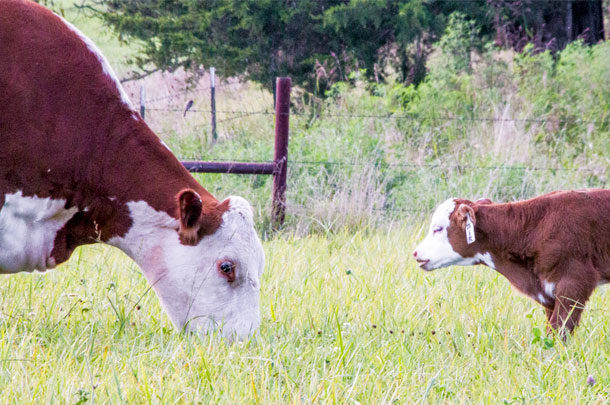What to plant after toxic tall fescue
When we get rid of toxic tall fescue, we are getting rid of a grass that persists in the field. Toxic tall fescue withstands pests, diseases and extreme weather conditions. We are also getting rid of a grass that provides forage over a long growing season, including the winter stockpile months. Finally, we are getting rid of a grass that has acceptable protein and energy levels, given that it is a perennial cool-season grass.
Those are some favorable traits. Are we sure we want to get rid of it? Well, yes. Absolutely. Despite those favorable traits, the old, tall fescue is toxic. Its toxins have a devastating effect on the health of our livestock as well as their performance, such as intake, gain, weaning weight, reproduction and milk production. But what other grass can take its place? Is there a grass that can persist in the field, that grows over the same growing period and can be stockpiled over winter, and that has similar forage quality? Yes.
As weird as it sounds, the ideal replacement grass for toxic tall fescue is another type of tall fescue – tall fescue infected with a novel endophyte, or as we commonly call it, “novel endophyte tall fescue.”
Novel endophyte tall fescue is not endophyte-free. Many of our callers confuse these two types of tall fescue. Endophyte-free tall fescue is simply tall fescue with no endophyte. It is nontoxic, sure. But because it lacks the endophyte, it lacks persistence. In most of the American tall fescue belt, endophyte-free tall fescue does not survive in grazed fields. It is susceptible to insect pests, diseases and drought.
In contrast, novel endophyte tall fescue does survive. Can it be overgrazed? Yes, of course, especially during its first year. But under normal management, it survives in the pasture. Its survival is caused by the endophyte. Yes, it is an infected tall fescue. But novel endophyte tall fescue is infected with a special strain of endophyte.This strain produces little or no toxin, so it is safe for cattle.
Also, novel endophyte tall fescue is similar to Kentucky 31 in its yield and quality. It grows well over the entire season and can be stockpiled, and it has the same protein and energy levels of the old Kentucky 31.
Converting toxic tall fescue to novel endophyte tall fescue
There are four major ways to plant a novel endophyte tall fescue:
- Spray-smother-spray (summer smother crop)
- Spray-smother-spray (winter smother crop)
- Spray-wait-spray (also called “dual spray”)
- Prepared seedbed
At this time of year, farmers need to be considering methods No. 1 and No. 3. The other methods begin later in the season.
The spray-smother-spray method with a summer smother crop involves three steps: 1) spraying the tall fescue in mid-spring, then 2) no-tilling a summer smother crop, then 3) spraying again in late summer before the new tall fescue is planted. This method of conversion was developed at the University of Missouri and is common in the lower Midwestern U.S.
Here are a few considerations when thinking of spray-smother-spray with a summer smother crop. First, spray the old tall fescue with a nonselective herbicide when it is growing well. The herbicide most often used is glyphosate, which works on actively growing plants.
Second, choose an annual cereal grass for the summer smother crop. The cereal grasses, such as sorghum-sudangrass or pearl millet, have “open canopies,” which differ from thick carpet-like stands that occur with forage crabgrass and annual ryegrass. The open canopy allows light to penetrate the stand and reach the volunteer seedlings and any of the old tall fescue that avoided the first spray.
Third, when planting the new tall fescue, don’t drill too deep. The no-till drill should cut through the stubble and place the seed ¼ inch in the soil. Fourth, don’t plant a companion crop with the new tall fescue. An exception is birdsfoot trefoil, which has poor seedling vigor, but other species can compete with the new fescue seedlings as they emerge.
The other method to consider this time of year is the spray-wait-spray method. This method was developed at the University of Georgia and has been used successfully across the southern U.S. In fact, it is beginning to be used in Missouri and states in the upper South.
Spray-wait-spray involves three steps in this order:
- Clip seedheads of old tall fescue in the spring
- Spray the field in the summer
- Spray the field again before planting the new tall fescue
The key to this method is timing of sprays. The University of Georgia has shown the sprays need to be at least six weeks apart. So it is best to determine when the last spray will be, then subtract six weeks to schedule the first spray. For example, if the last spray will be September 1, just prior to planting the new tall fescue, the first spray would occur about July 15 or before.
As stated above, it is wise to plant the new tall fescue ¼-inch deep and as “straight grass.” If legumes are to be added, they can be frost-seeded into the newly established pasture.
Stay tuned to Progressive Forage, as later issues will include articles that detail how to convert these toxic pastures in the fall of the year. ![]()
Craig Roberts is a professor of agronomy at the University of Missouri. Email Craig Roberts.
PHOTO: Converting pasture from toxic tall fescue to novel endophyte tall fescue means better cattle gains, reproduction and health. Staff photo.









